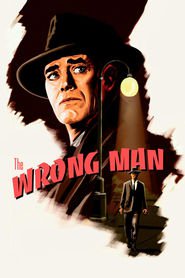
One of Alfred Hitchcock’s reoccurring themes throughout his movies is the theme of the wrongly accused innocent. His one film that directly deals with this topic as its main emphasis actually became an outliner in Hitches repertoire as rather then deal in an exciting, suspenseful tale, the movie dwells on the actual horror of being wrongly accused without a lot of emphasis being put on any actually crime or adventure.
In every film but one, Hitchcock stamps his imprint via a quick speechless cameo appearance and it is always fun to try and catch this appearance while watching his films. The one film that he does not appear in a cameo is, “The Wrong Man” In this movie he meets us straight on at the beginning of the movie speaking into the camera and telling the audience that every word uttered and shown in the movie is true, foregoing any real suspense. For the film is not a suspense story, but rather a true life horror of an innocent man accused of being an armed thief.
Henry Fonda gives one of his greatest performances in playing the poor Christopher “Manny” Balestrero, who is identified mistakenly by a bank clerk as being the thief who held her up a few months previously.
We first meet Manny, at his job as a bassist in a jazz band, playing in a ritzy club in New York. A good family man with a pretty wife and two small boys. The false accusation results in his arrest, jailing and trial. His wife goes insane and his family is destroyed. We see everything shown in the family with the first person view point of Manny. His dismay and bewilderment at the beginning develops into shock, realization and terror as he is booked and made into a number in the prison system. He is not just an innocent man but a good, non-drinking, wholesome family man and his complete helplessness at the injustice and evil being done to him is hard to witness.
The plot itself as Hitchcock tells us in the beginning is based on a true story and book and for once the names and characters remain the same as in real life.
Hitchcock first allows us to know our victim by introducing us to him one night playing his bass and riding the subway to his modest home. We see his interests shown to us via Hitchcock’s famous use of close ups. He is a man with modest means and who dreams of having more and enjoys the occasional gamble. The camera allows us to follow his interests through the newspaper he reads on the train. His home is shown as happy and full of love. On the very next evening the police are waiting at his home which starts the agonizing torture of being wrongly accused of a serious crime.
There are heavy influences from Bressen’s, “A man escapes”, as Manny, while being driven to the police station, is shown locked on either side by the police. He is forced to do all that is asked of him which results in the appearance of his apparent guilt.
One strong scene has Manny being identified by the bank clerks in a police lineup where he is identified as the fourth person and the camera shows a detached angle to the police, then away from the clerks as they count the lineup suspects to focus on Manny’s terrified face as he is being accused and unable to respond to his accusations. It is a powerful scene of terrible fear and helplessness. Then later Hitch uses his close up emphasis on showing the black fingerprinted tips of Manny’s hands as if the black stains were the mark of Cain.
Later in his prison cell, Hitch once again borrows from Bressen’s film as we see Manny take in his new world of a prison cell. The camera takes in his viewpoint scanning the cell from top to bottom, ending at the eye sized gap in the door that is the only outlet from his cell. While in his cell we hear, quietly his name being called over and over again until he himself hears it and we are jilted to the outside of the cell with a close up of his fearful eyes. There is no real suspense in the movie other than the realization that fate and luck or lack of luck are the only things that matters.
“The Wrong Man”, is a true story concerning organized machines of civilization and their power to control whoever they set their intentions upon. The movie has no plot of moving adventure and concerns itself with feelings, atmosphere and terror that surround these actual events.
The film has no large fancy set pieces that Hitchcock was so famous for but makes use of first point viewpoint shots, famous Hitch close-ups and great black and white cinematography to envelope the viewer into the feeling and mind of its victim. This is what makes it a great movie

